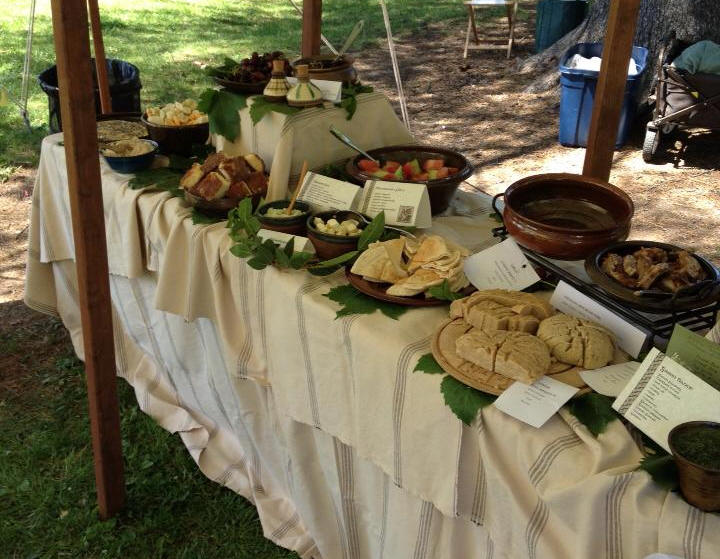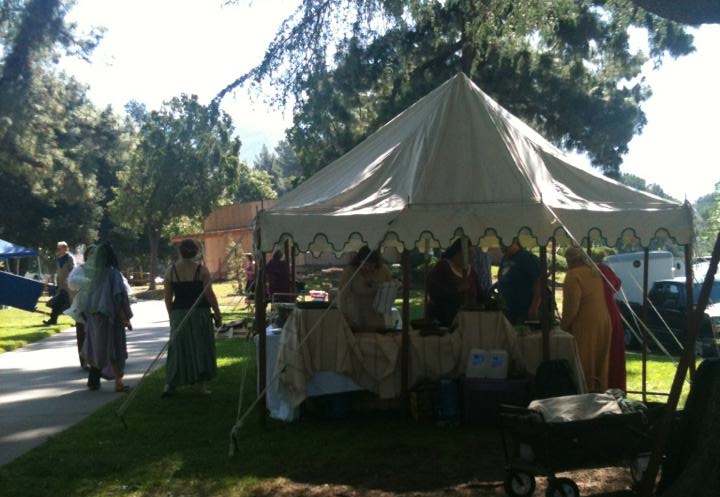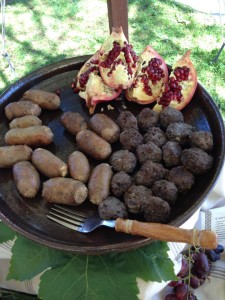A dear friend was recently invited to join the Order of the Laurel. I naturally wanted to help out with her Vigil refreshment table, which was to reflect a Roman picnic theme. The Vigil Coordinator asked if I would do a sausage similar to Lucanicae, a spicy, smoked sausage from Apicius (an ancient collection of Roman recipes).
 Roman? What does Beathog know of Roman, I ask? Of course, Rome’s military presence in Scotland was long gone before the 14th century, but the Roman legacy has endured, in the western world, throughout history. The actual military presence of Rome lasted for about 40 years in Scotland, but at no time was even half of Scotland under Roman control. I wondered if Scottish cooks could have been influenced by Rome, as there are very few recorded period Scottish recipes, causing us to look elsewhere for possible influences. As it turns out, it was the Vikings who introduced the idea of smoking food in the newly formed Kingdom of Scotland, in the 9th century, and smoking food has remained popular — one of their most popular traditional foods is smoked haddock (Arbroath Smokies).
Roman? What does Beathog know of Roman, I ask? Of course, Rome’s military presence in Scotland was long gone before the 14th century, but the Roman legacy has endured, in the western world, throughout history. The actual military presence of Rome lasted for about 40 years in Scotland, but at no time was even half of Scotland under Roman control. I wondered if Scottish cooks could have been influenced by Rome, as there are very few recorded period Scottish recipes, causing us to look elsewhere for possible influences. As it turns out, it was the Vikings who introduced the idea of smoking food in the newly formed Kingdom of Scotland, in the 9th century, and smoking food has remained popular — one of their most popular traditional foods is smoked haddock (Arbroath Smokies).
<><><>
LVCANICAE
lucanicas similiter ut supra scriptum est. [lucanicarum confectio]: teritur piper cuminum satureia ruta petrosilenu condimentum bacae lauri liquamen et admiscetur pulpa bene tunsa ita ut denuo bene cum ipso subtrito fricetur; cum liquamine admixto pipere integro et abundanti pinguedine et nucleis inicies in intestinum perquam tenuatim productum et sic ad fumum suspenditur
Lucanian sausage
Lucanian sausage [is prepared] as written above. Pound pepper, cumin, savory, rue, parsley, spice of bayberry. Also add liquamen and meat that has been pounded well, in such a way that it blends well with the pounded [spices]. Add liquamen with whole peppercorns, plenty of fat and pinenuts. Put it in skins, draw them quite thinly, and hang them in the smoke.
<><><>
“… and hang them in the smoke.”
It was evident these sausages were to be smoked as a method of preservation, not as a method of cooking that adds flavor, as we are so fond of today. Using modern terminology, these are meant to be cold smoked, rather than hot smoked. And VERY quickly in my research I learned two things: 1) improper cold smoking can result in people dying, and 2) cold smoking cannot be done properly in the summer, as temperatures are too high. And, “not summer” here in Southern California translates to “winter”.
SO, I would be adapting this recipe, hot smoking them (to add flavor), and then pan frying to finish. Interesting to note, they were served, still cool, from the cooler and tasted very much like a smoked “picnic” sausage — they even had the characteristic internal pink color.
I found the subject of cold smoking fascinating, however! I am going to do a lot more research and try my hand at it this winter. In addition, this recipe introduced me to another new subject, Liquamen (or Garum, as I have heard it called) — or, simply, Roman fish sauce. Since this date, I have had much more experience with it and cannot wait to try my hand at making it from scratch (stay tuned!). What a fascinating and delicious ingredient! This sauce is used to salt dishes (another important part of preservation), but it actually adds moisture to a dish in the process. I was able to substitute the readily available Vietnamese fish sauce, Nuoc Mam, for this recipe.
This was a delicious recipe! It was well received, so my husband and I were asked to make them, again, for Gyldenholt Anniversary. We have added another very delicious sausage recipe to our repertoire!


